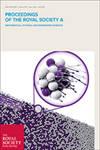Detailed analyses of grain–scale plastic deformation in columnar polycrystalline aluminium using orientation image mapping and crystal plasticity models
Proceedings of the Royal Society of London. Series A. Mathematical and Physical Sciences
Pub Date : 2004-07-08
DOI:10.1098/rspa.2003.1260
引用次数: 98
Abstract
Deformation studies at grain level have been performed in order to model how individual crystals in a polycrystalline material deform. The experiment was carried out by plane–strain compression of a high–purity polycrystalline aluminium with columnar grain structure with near ⟨100⟩ fibre texture parallel to the constrained direction in the channel die. This structure was chosen to allow a fully three–dimensional characterization of the grain structure. The grain orientations were mapped by orientation image microscopy, as the directionally solidified material was deformed in steps of 10% to a total height reduction of 40%. The grains were found either to show nearly uniform rotations or to split into two types of deformation bands, either with repeating orientation fields or with non–repeating orientation fields. The Taylor model and the finite–element method (FEM) were, as usual, quite successful in predicting the average deformation texture, but the Taylor model failed totally to predict the rotation of individual grains. The FEM was more successful in predicting the individual grain rotations but did not, as in a previous study, predict the morphology of the deformation bands. The significant discovery, made here, was that it appeared possible to model the local deformation at a grain scale, from the observed individual deviations of the grain rotations from those predicted if each grain underwent just the plane–strain conditions imposed on the sample. Plastic work rates were computed allowing four shears (two shears in each of the two contact planes) that are compatible with the channel–die geometry. It was found that in all the ‘hard’ grains (those with high Taylor factors), the additional shears (in type and magnitude) that minimized the plastic energy dissipation rate were the same shears that were needed to match the observed grain rotations. Adjacent Taylor ‘soft’ grains were found to have been subjected to the additional shears imposed by their neighbouring hard grains. This was true even when these shears raised the plastic work of the soft grains. This effect was most marked when the soft grains were small in size. These additional shears found by this plastic work analysis were consistent with the observed additional shear seen in the overall shape change of the sample. The grains forming non–repeating orientation fields had low initial Taylor factors and were surrounded by high–Taylor–factor grains, usually of larger size, but which had adopted somewhat different extra shears. The grains showing repeating orientation fields were found to have an orientation, near ‘cube’, (001) ⟨100⟩, which was initially unstable, leading to a break–up into different orientation fields when deformed. These differing deformation bands in the cube grains followed different strain paths, which also minimized their plastic work.利用取向图像映射和晶体塑性模型对柱状多晶铝的晶粒级塑性变形进行了详细分析
为了模拟多晶材料中的单个晶体如何变形,在晶粒水平上进行了变形研究。实验是通过平面应变压缩高纯度多晶铝进行的,其柱状颗粒结构具有接近⟨100⟩的纤维纹理,平行于通道模具中的约束方向。选择这种结构是为了对晶粒结构进行完全的三维表征。取向成像显微镜绘制了取向凝固材料的取向图,在此过程中,定向凝固材料的变形幅度为10%至总高度降低40%。结果表明,晶粒或呈现出几乎均匀的旋转,或分裂成具有重复取向场和不具有重复取向场的两种变形带。通常,Taylor模型和有限元法(FEM)在预测平均变形织构方面非常成功,但Taylor模型完全无法预测单个晶粒的旋转。有限元法在预测单个晶粒的旋转方面比较成功,但没有像以前的研究那样预测变形带的形貌。这里的重大发现是,如果每个晶粒只经历施加在样品上的平面应变条件,那么从观察到的晶粒旋转与预测的个体偏差来看,似乎有可能在晶粒尺度上模拟局部变形。计算了与通道模具几何形状兼容的四个剪切器(两个接触面各有两个剪切器)的塑性工作速率。研究发现,在所有“硬”晶粒(泰勒系数高的晶粒)中,使塑性能量耗散率最小化的额外剪切(在类型和大小上)与观测到的晶粒旋转相匹配所需的剪切相同。相邻的泰勒“软”颗粒被发现受到了邻近硬颗粒施加的额外剪切。即使这些剪刀提高了软颗粒的塑性,情况也是如此。当软粒尺寸较小时,这种效果最为明显。通过塑性功分析发现的这些附加剪切与观察到的附加剪切在样品的整体形状变化中一致。形成非重复取向场的晶粒具有较低的初始泰勒因子,并被高泰勒因子的晶粒包围,这些晶粒通常尺寸较大,但采用了不同的额外剪切力。显示重复取向场的颗粒被发现有一个取向,接近'立方体',(001)⟨100⟩,它最初是不稳定的,导致变形时分裂成不同的取向场。这些立方体晶粒中的不同变形带遵循不同的应变路径,这也使它们的塑性工作最小化。
本文章由计算机程序翻译,如有差异,请以英文原文为准。
求助全文
约1分钟内获得全文
求助全文
来源期刊
自引率
0.00%
发文量
0
期刊介绍:
Proceedings A publishes articles across the chemical, computational, Earth, engineering, mathematical, and physical sciences. The articles published are high-quality, original, fundamental articles of interest to a wide range of scientists, and often have long citation half-lives. As well as established disciplines, we encourage emerging and interdisciplinary areas.

 求助内容:
求助内容: 应助结果提醒方式:
应助结果提醒方式:


